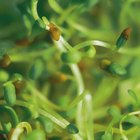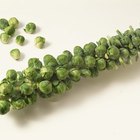
Collard greens are a cool-season crop most readily available in local markets during the fall, winter and spring. The plants are mostly water; they toughen quickly after harvest and may become bitter. Proper cooking techniques lessen or eliminate the bitter taste, but be careful not to overcook them, which will cause them to lose nutrients and develop a bland flavor and texture.
Selecting Collard Greens
For the freshest flavor, grow your own collard greens or buy them at a farmers' market or through a local source. Choose bunches with small, thin leaves over large, thick leaves when possible for the mildest flavor. Pass by any that are wilted or have brown spots, indicating they aren't fresh. Store them in an open plastic bag in your refrigerator and use them within three days. They toughen and become more bitter as they age.
Cooking Collard Greens
Simmer, boil or saute' collard greens to reduce bitterness, rather than steaming them. The liquid and oil helps dissipate the bitterness. Simmer or boil collard greens in water or even chicken broth, stirring frequently. Remove them from the heat when the greens are slightly wilted, but still dark green, with a sweet flavor. If the greens are still bitter, return them to the heat for a few more minutes. Saute' freshly washed and slightly wet collard greens in a bit of olive oil. Add garlic or bacon for extra flavor. Taste them when they become wilted to ensure that the bitter flavor is gone.
Using Collard Greens
Serve collard greens with just a dash of vinegar and salt and pepper, or dress them up with peanut sauce or a sesame ginger dressing. Cut them finely and disguise them in soups and stews to thwart picky eaters, or add them to stir-fries. Wash collard greens two times in a salad spinner to remove any grit prior to cooking.
Nutrition
Collard greens are low in fat and packed with nutrition, making it worth your while to find pleasing preparation methods. One cup of collard greens has only 20 calories, 3.5 grams of fiber and 137 mg. of calcium. Collard greens are also a good source of folate, vitamin A and vitamin C. Once you've become accustomed to collard greens, try kale, mustard greens and turnip greens.
Related Articles

How to Refresh Dried Fruits: Raisins

How to Cook Kale in a Pan With Butter ...

How to Remove a Cardamom Seed From a Pod

How to Remove Bitterness From Brussels ...

How to Cook Mixed Greens

How to Eliminate Bitterness in Broccoli
How to Store Your Fresh Cut Kale

How to Cook Mustard & Turnip Greens in ...

How to Take Care of a Wet & Wavy Weave

How to Store Brussels Sprouts

How to Blanch Kale for Freezing

Why Do Sprouts Taste Bitter?

How to Cook Kale Raab

How to Roast Maple and Brown Sugar ...
How to Clean and Cook Broccoli Rabe

How to Cook Brussel Sprout Greens

Cooking Kale Greens

The Best Way to Cook Turnip Greens
How Do I Clean Water Cress?

How to Make Black Clothing Look Good ...
References
Resources
Writer Bio
Julie Christensen is a food writer, caterer, and mom-chef. She's the creator of MarmaladeMom.org, dedicated to family fun and delicious food, and released a book titled "More Than Pot Roast: Fast, Fresh Slow Cooker Recipes."
Photo Credits
Brand X Pictures/Brand X Pictures/Getty Images